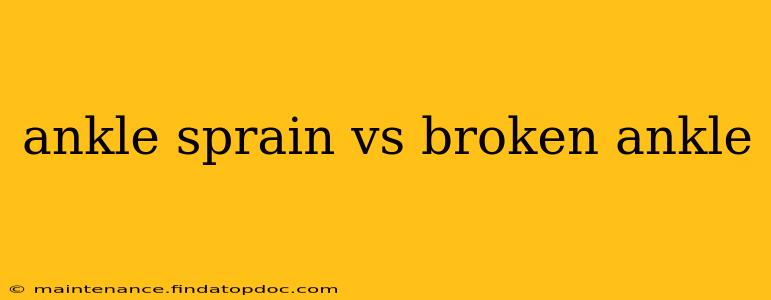Ankle injuries are incredibly common, affecting athletes and non-athletes alike. Distinguishing between an ankle sprain and a broken ankle (ankle fracture) is crucial for appropriate treatment and recovery. While both can cause significant pain and swelling, they require different approaches to healing. This guide will help you understand the key differences and when to seek medical attention.
What is an Ankle Sprain?
An ankle sprain occurs when the ligaments—the strong bands of tissue that connect bones—in your ankle are stretched or torn. This typically happens due to a sudden twisting or rolling of the ankle, often during sports, falls, or uneven surfaces. The severity of a sprain is graded from mild (Grade 1) to severe (Grade 3), depending on the extent of ligament damage.
- Grade 1 Sprain: Mild stretching or minor tearing of ligaments.
- Grade 2 Sprain: Partial tearing of ligaments.
- Grade 3 Sprain: Complete tear of ligaments.
Symptoms of an ankle sprain include pain, swelling, bruising, instability, and difficulty bearing weight. While painful, a sprained ankle usually doesn't involve a bone fracture.
What is a Broken Ankle?
A broken ankle, or ankle fracture, involves a break in one or more of the bones that make up your ankle joint: the tibia (shinbone), fibula (smaller bone in the lower leg), and talus (ankle bone). These fractures often result from high-impact injuries, such as falls from significant heights, motor vehicle accidents, or direct blows to the ankle. The severity of a fracture can range from a small crack (hairline fracture) to a complete break in the bone.
Symptoms of a broken ankle include intense pain, significant swelling, bruising, deformity (the ankle might look misshapen), inability to bear weight, and possible numbness or tingling.
How Can I Tell the Difference?
Differentiating between an ankle sprain and a broken ankle can be challenging, even for medical professionals. Several factors are considered:
- Mechanism of Injury: How did the injury occur? A twisting injury is more suggestive of a sprain, while a high-impact event points towards a fracture.
- Pain Level: The pain associated with a fracture is typically more intense and debilitating than that of a sprain.
- Swelling: While both conditions cause swelling, the swelling associated with a fracture is often more pronounced and rapid.
- Deformity: A visible deformity or misalignment of the ankle strongly suggests a fracture.
- Ability to Bear Weight: Difficulty or inability to bear weight on the injured ankle is a serious sign that needs immediate medical attention. This is a stronger indicator of a fracture.
- Physical Exam: A doctor will perform a thorough physical exam, assessing range of motion, tenderness, and stability. They might order X-rays to confirm the diagnosis.
What are the Treatment Options?
Treatment for ankle sprains and fractures differs significantly:
Ankle Sprain Treatment: Generally involves the RICE protocol (Rest, Ice, Compression, Elevation) along with pain relievers. Physical therapy may be necessary for more severe sprains to restore range of motion and strength.
Broken Ankle Treatment: Often requires immobilization with a cast, splint, or boot to allow the bone to heal properly. In severe cases, surgery may be needed to realign the bones and stabilize the joint.
How Long Does It Take to Recover?
Recovery time varies depending on the severity of the injury and individual factors. Mild ankle sprains may heal within a few weeks, while severe sprains and fractures can take several months.
Can I treat an ankle sprain or broken ankle at home?
While home treatment can be appropriate for mild ankle sprains (RICE, over-the-counter pain relievers), it's crucial to seek medical attention for any suspected fracture or severe sprain. Attempting to treat a broken ankle at home can lead to complications and delayed healing.
When Should I See a Doctor?
You should seek immediate medical attention if you experience:
- Intense pain
- Significant swelling
- Deformity of the ankle
- Inability to bear weight
- Numbness or tingling
- Persistent pain or swelling after several days of home treatment
What are the long-term effects of an ankle sprain or fracture?
Long-term effects are more likely after a severe injury or incomplete healing. These can include chronic pain, instability, osteoarthritis, and limited range of motion. Following your doctor's recommendations for treatment and rehabilitation is critical to minimizing these risks.
This information is for general knowledge and does not constitute medical advice. Always consult a healthcare professional for diagnosis and treatment of any ankle injury.
